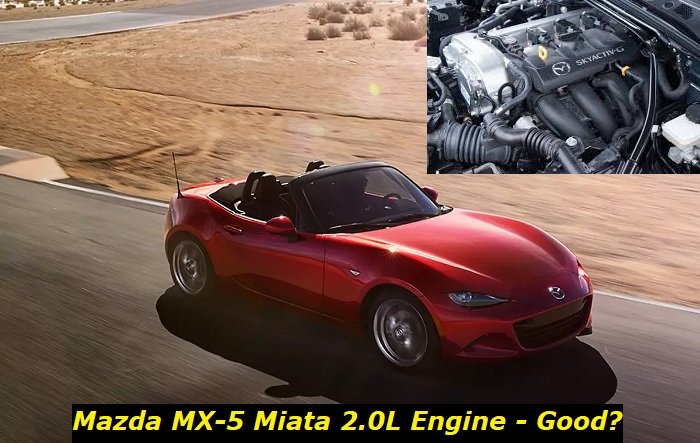The new Mazda MX-5 Miata that is sold now in the US is a living legend. This is the fourth generation of the model that has been manufactured since 2015. It sells about 8,000 models a year in the US and is still thought to be one of the most desirable roadster vehicles in the class. The convertible version that's offered in the US market right now has the base 2.0L engine that I want to tell you about today.
The 2.0L non-turbo PE-VPS engine in the Mazda MX-5 Miata is the PE-VPS machine that was updated in 2019. I will tell you more about its engineering and features. The engine appears to be very reliable but a pretty strange choice for this car where you would expect to see a powerful turbo machine under the hood.

Key features and my opinion about the engine
- Production years:2012-now
- Average lifespan of PE-VPS:190,000-220,000 miles
- Fuel supply type:direct injection
- Power range:150-165 hp
- Fuel efficiency:good
- Engine block material:aluminum
- Engine reliability score:medium
- The most common problems:software problems in early years, fuel system contamination, problems with drive belt, electronic thermostat issues.
Key facts about the 2.0L engine in the MX-5
So, this engine is not really new, the first PE-VPS model was introduced peon 2012 and has been installed in many Mazda models. But in 2019, Mazda decided to update the engine without changing its code and name. The new updated engine was used in the Miata only. The updated version has a new exhaust, higher fuel pressure, 181 horsepower instead of 150-165 hp before, and also a larger intake manifold. The new model can rotate up to 7500 RPM.
The engine was significantly modified and got more power and torque. It could even be marketed as an absolutely new engine, so we will consider that the 2023 MX-5 Miata comes with an engine developed in 2019.
Here are some key facts about the machine:
- this is the 2.0L 4-cylinder non-turbocharged engine with the aluminum block and head, with 4 valves per cylinder and DOHC;
- the engine offers 181 horsepower and 151 lb-ft of torque - this is quite a lot for a naturally aspirated 2-liter machine;
- it's fitted with direct injection and no port injectors, so the carbon buildup problem is there to come;
- the engine is fitted with a dual phaser, so both camshafts are controlled and the valve timing is changed for more efficiency;
- the timing system is powered by the chain - the chain is pretty durable but still needs some attention at high-mileage engines;
- the standard transmission is a 6-speed manual while you can also get the 6-speed automatic (Skyactiv Drive) as an option;
- this engine offers 26 MPG in the city and up to 34 MPG on highways which is not that bad.
Well, the machine doesn't look bad at all. It has a simple design and a lot of well-known technologies that make it durable. There is nothing that can go bad after 30K miles and you may be pretty sure that the engine will go a decent number of miles or years. Of course, the eventual longevity depends on many things.
I should say that the 2.0L non-turbo engine is really cool to drive in the Mazda MX-5 Miata no matter which transmission you choose. This is a great engine that balances between durability and fun driving. You won't feel that the vehicle is sluggish or lacks some power.
How many miles will the MX-5 engine last?
So, we now know that this engine doesn't have many unpredictable technologies that can compromise its durability. I can suppose that the average lifespan of this machine should be considered about 220,000 miles. It's not that much for a simple 2-liter engine, but it's a huge longevity for a roadster-convertible car.
Also, both types of transmissions are going to live as long as the engine or even longer. This is important because very often the lifespan of the car depends on the transmission, nowadays. The manual transmission is just eternal in the MX-5 Miata while the automatic option will require one serious repair during the life of the car.
Overall, the engine is durable. But you should understand that poor maintenance and abusive driving may kill it much faster than average. Also, you may know that a lot of TLC and careful driving will allow you to drive this car up to 250-260 thousand miles with no expensive repairs or unexpected breakdowns.
What are the common problems with the PE-VPS in the MX-5?
To avoid serious repairs and prevent issues with this engine, you should know about its common problems. They show up at a certain mileage, so they are usually not spontaneous and you can predict them.
Here are some serious issues that you should pay attention to:
1. Thermostat failure
At almost any mileage, the smart thermostat may fail in this car. It's electronically controlled in the PE-VPS and it's very unreliable. All Mazda MX-5 owners should pay attention to engine temperature. If the gauge shows some abnormal behavior, it's recommended to stop the vehicle and avoid overheating.
If the MX-5 engine is overheated, it may get a faulty head. And if the problem is ignored and the overheated engine is driven further, the fatal damage is guaranteed. So, if you see the engine overheating, you should stop the vehicle and let it cool down. Check the thermostat, in the first place.
2. Drive belt issues
The drive belt is pretty good as well as almost all the parts of the system. But there is one nasty thing that spoils the pleasure. It's the pulley that's made of plastic. This plastic pulley is very often worn out way before you expect this to happen and the belt may get stuck and break.
This doesn't cause many serious problems but driving your car will be pretty hard, in this case. Almost nothing will work correctly. Of course, after such an event, you should drive directly to the dealership or a good shop to have the issue repaired.
3. Tender fuel supply system and ignition coils
If you experiment with the quality of fuel, the MX-5 engine may appear to be unreliable. Ignition coils will fail one after another, and the fuel supply system will get clogged. You will need to clean the injectors, replace the coils and spark plugs, and replace the fuel pump quite often. But there is one magic thing that can change everything back to normal - high-quality and clean fuel.
Actually, bad gasoline may bring even more problems to the Miata engine. It can kill it by activating cylinder misfiring and knocking.
4. Chain problems
The timing system is driven by the chain. This is a good thing because chains live longer than belts. And Mazda doesn't even have the interval of chain replacement. One may think that this means the chain should live as long as the engine. Maybe, it should, but in real life, it doesn't.
If you don't replace the chain at about 120,000 miles, it may just break or fatally stretch and jump. This will inevitably lead to issues with the valves and pistons and also some other parts of the engine.
5. Different minor problems
This engine is not problem-free and it will bother you with numerous minor issues. They are easy to locate and solve but anyway, you will not expect this to happen with a new car.
It can throw different codes, misfire, lose power, show numerous combinations of warning lights, etc. Fortunately, a good OBD2 scanner easily finds the problem and a good mechanic easily repairs the engine.
There is one bad thing in this - any OEM part for the Mazda engine will cost quite a lot.
By the way, I've written the article about one of the common problems with all modern Mazda car - keyless system malfunction issue. Have a look to know this before it happens.
Prolonging the life of the Mazda MX-5 engine
So, the 2.0L PE-VPS engine in the Mazda MX-5 Miata is not bad at all. But how can you make it even better and drive this engine well beyond its average lifespan? I should say it's possible.
And here's what you should do for this:
- change oil and filters more often than Mazda suggests you should do;
- buy OEM parts and fluids when it comes to engine repairs;
- forget about abusing this engine - it's not made for sport and super-active driving;
- don't ignore minor issues because they may quickly escalate to fatal problems;
- warm up the engine at least for about 30-40 seconds before you start driving it in the morning.
Final thoughts
So, the 2.0L engine in the Mazda MX-5 Miata is a really good machine that is capable of going up to 220,000 miles with average service and driving style. You can even get more if you follow the tips I've given you above in this article.
The engine is great to drive. It's really powerful for a non-turbo powerplant and it gives real pleasure on the road in this small and stylish vehicle. The MX-5 Miata doesn't seem to go worse than its turbocharged counterparts, so it's really worth buying. But, as you see after reading this article, the engine is not problem free and it requires some attention.
About the authors
The CarAraC research team is composed of seasoned auto mechanics and automotive industry professionals, including individuals with advanced degrees and certifications in their field. Our team members boast prestigious credentials, reflecting their extensive knowledge and skills. These qualifications include: IMI: Institute of the Motor Industry, ASE-Certified Master Automobile Technicians; Coventry University, Graduate of MA in Automotive Journalism; Politecnico di Torino, Italy, MS Automotive Engineering; Ss. Cyril and Methodius University in Skopje, Mechanical University in Skopje; TOC Automotive College; DHA Suffa University, Department of Mechanical Engineering






Add comment